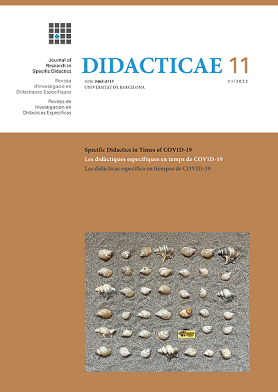Implementación y análisis de un patio científico en la etapa de educación infantil
Implementation and analysis of a scientific schoolyard in early childhood education
DOI:
https://doi.org/10.1344/did.2022.11.188-206Keywords:
science, scientific schoolyard, scientific skills, experimentation, early childhood educationAbstract
The current state of early childhood education reveals two aspects which have motivated this study. Firstly, schoolyards do not usually have resources which promote learning, and, secondly, science is seen as something immeasurable and distant at this education stage. For these reasons, the present study aims to design different scientific proposals to be implemented in the schoolyard of a Catalan school and to analyze how children between 3 and 5 years of age interact and learn with them. Through this qualitative study, based on non-participant observations of the context, it is shown how this school space can be stimulated by supplying proposals which students can freely explore. These proposals contribute to inclusion, to the generation of positive experiences and to the
development of scientific skills among early childhood education students.
References
Atmodiwirjo, P. (2013). School ground as environmental learning resources: Teachers’ and pupils’ perspectives on its potentials, uses and accessibility. International Electronic Journal of Environmental Education, 3(2), 101-119. https://bit.ly/3iy9B0D
Ayotte-Beaudet, J-P., Potvin, P., Lapierre, H. G. y Glackin, M. (2017). Teaching and learning science outdoors in schools’ immediate surroundings at K-12 levels: A meta-analysis. EURASIA Journal of Mathematics Science and Technology Education, 13(8), 5343-5363. http://dx.doi.org/10.12973/eurasia.2017.00833a
Bisquerra, R. (2004). Metodología de la investigación educativa (1.a ed.). Editorial La Muralla.
Castro-Pérez, M. y Morales-Ramírez, M. E. (2015). Los ambientes de aula que promueven el aprendizaje, desde la perspectiva de los niños y niñas escolares. Revista Electrónica Educare, 19(3), 1-32. http://dx.doi.org/10.15359/ree.19-3.11
Christidou, V., Tsevreni, I., Epitropou, M. y Kittas, C. (2013). Exploring primary children’s views and experiences of the school ground. The case of a Greek school. International Journal of Environmental & Science Education, 8(1), 59-83. https://bit.ly/3xyRD2e
COSCE (Confederación de Sociedades Científicas de España). (2011). Informe ENCIENDE. Madrid: Confederación de Sociedades Científicas de España. https://www.cosce.org/pdf/Informe_ENCIENDE.pdf
Dyment, J. E., Bell, A. C. y Lucas, A. J. (2009). The relationship between school ground design and intensity of physical activity. Children’s Geographies, 7(3), 261-267. http://dx.doi.org/10.1080/14733280903024423
Dyment, J. y O’Connell, T. S. (2013). The impact of playground design on play choices and behaviors of pre-school children. Children’s Geographies, 11(3), 263-280. http://dx.doi.org/10.1080/14733285.2013.812272
Epstein, A. S. (2007). Essentials of active learning in preschool: Getting to know the HighScope curriculum. HighScope Press.
Eshach, H. y Fried, M. (2005). Should science be taught in early childhood? Journal of Science Education and Technology, 14(3), 315-336. http://dx.doi.org/10.1007/s10956-005-7198-9
Ferreira, J. M., Karila, K., Muniz, L., Amaral, P. F. y Kupiainen, R. (2018). Children’s perspectives on their learning in school spaces: What can we learn from children in Brazil and Finland? International- Journal of Early Childhood, 50(3), 259-277. https://bit.ly/3xtkZis
Fleer, M. y Hardy, T. (2001). Science for children: Developing a personal approach to teaching (2nd ed). Prentice-Hall.
Gallardo, V. B. y Turkienicz, B. (2018). Converting the schoolyard into a learning space: A strategy for public education. Space and Culture, 23(4), 444-261. https://doi.org/ghvh8s
Gómez-Motilla, C. y Ruiz-Gallardo, J. R. (2016). El rincón de la ciencia y la actitud hacia las ciencias en educación infantil. Revista Eureka sobre Enseñanza y Divulgación de las Ciencias, 13(3), 643-666. https://doi.org/gqz6
González, A., Guix, V. y Carreras, A. (2016). La transformación de los patios escolares: una propuesta desde la coeducación. Revista Aula, 255, 67-72. https://bit.ly/3Czg4QU
Gopnik, A., Meltzoff, A. N. y Kuhl, P. K. (1999). The scientist in the crib: Minds, brains, and how children learn. William Morrow & Co.
Gopnik, A. y Wellman, H. M. (2012). Reconstructing constructivism: Causal models, Bayesian learning mechanisms, and the theory theory. Psychological Bulletin, 138(6), 1085. http://dx.doi.org/10.1037/a0028044
Rennie, L.J. y Johnston, D.J. (2004). The nature of learning and its implications for research on learning from museums. Science Education, 88, S4-S16. https://doi.org/cgm7n3
Riera, M.A., Ferrer, M. y Ribas, C. (2014). La organización del espacio por ambientes de aprendizaje en la Educación Infantil: significados, antecedentes y reflexiones. RELAdEI. Revista Lationoamericana de Educación Infantil, 3(2), 19-39. https://bit.ly/2U2ZlUv
Rinaldi, C. (2006). Dialogue with Reggio Emilia: Listening, researching and learning. Routledge.
Saçkes, M. (2014). Parents who want their PreK children to have science learning 8S/experiences are outliers. Early Childhood Research Quarterly, (29), 132-143. http://dx.doi.org/10.1016/j.ecresq.2013.11.005
Saldaña, D. (2018). Reorganizar el patio de la escuela, un proceso colectivo para la transformación social. Hábitat y Sociedad, 11, 185-199. https://doi.org/gqz9
Sevilla, Y. O. (2010). Diseño de espacios educativos significativos para el desarrollo de competencias en la infancia. Revista CS, 71-96. http://dx.doi.org/10.18046/recs.i5.452
Subirats, M. y Tomé, A. (2010). Balones fuera: reconstruir los espacios des de la coeducación. Octaedro.
Ting, K. L. y Siew, N. M. (2014). Effects of outdoor school ground lessons on students’ science process skills and scientific curiosity. Journal of Education and Learning, 3(4), 96-107. http://dx.doi.org/10.5539/jel.v3n4p96
Tranter, P. J. y Malone, K. (2014). Geographies of environmental learning: An exploration of children’s use of school grounds. Children’s Geographies, 2(1), 131-155. https://doi.org/bzq2sg
Downloads
Published
Issue
Section
License
Copyright (c) 2021 David Aguilar Camaño

This work is licensed under a Creative Commons Attribution-ShareAlike 4.0 International License.
The authors who publish in this journal agree to the following terms:
- Authors retain copyright and grant the journal the right of first publication.
- Submitting a paper does not involve paying any fees.
- Texts will be published under a Creative Commons Attribution Share-Alike 4.0 International License that allows others to share the work, provided they include an acknowledgement of the work’s authorship, its initial publication in this journal and the terms of the license.
- When citing works published in Didacticae, both the autor and the journal must be cited.
- Didacticae does not accept any responsibility for the points of view and statements made by the authors.



